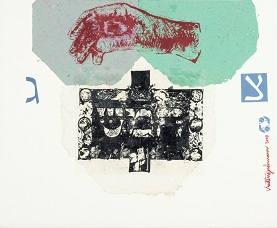The Amazonida Jewish Identity in Paulo Jacob
the Third Margin of the River
DOI:
https://doi.org/10.35699/1982-3053.2021.34437Keywords:
Paulo Jacob, Amazônia, IdentifyAbstract
Our article deals with the autobiographical novel Um pedaço de lua caía na mata (1990) by the Jewish writer Paulo Jacob (1921-2003). This work portrays the history of Sephardic Jewish immigration in the Amazon region through the journey of exile of the protagonist Salomão. Our thesis is that each period of your life – sailing on the boat Jerusalem and docking in Parintins – would correspond to a dimension of Jewish identity: "Hebrewism" and "Israelism", second André Neher (2007). Divided between opening up to the world or preserving his uniqueness as a Jew, the construction of a “third-space”, in the conception of Homi Bhabha (2007), uniting Jewish mystique to Amazonian folklore, allows him to transfigure this internalized conflict. Jacob thus proposes the construction of an Amazonida Jewish identity.
Downloads
References
BAKHTIN, Mikhaïl. Esthétique et théorie du roman. Tradução de Daria Olivier. Paris: Gallimard, 1978.
BATISTA, Djalma. O complexo da Amazônia. Análise do processo de desenvolvimento. Rio de Janeiro: Conquista, 1976.
BHABHA, Homi K. Les lieux de la culture. Une théorie postcoloniale. Tradução de Françoise Bouillot. Paris: Éditions Payot et Rivages, 2007.
BLAY, Eva Alterman. Judeus na Amazônia. In: SORJ, B. (org). Identidades judaicas no Brasil contemporâneo [online]. Rio de Janeiro: Centro Edelstein de Pesquisas Sociais, 2008. p. 25-57. Disponível em: http://me.precog.com.br/bc-texto/obras/sorj-9788599662601.pdf. Acesso em: 4 jun. 2021.
BOSI, Alfredo. História concisa da literatura brasileira. São Paulo: Cultrix, 1994.
CARNEIRO, Maria Luiza Tucci. Dez mitos sobre os judeus. São Paulo: Ateliê Editorial, 2019.
CHEVALIER, Jean; GHEERBRANT, Alain. Dictionnaire des symboles. Paris: Éditions Robert Laffont, S.A. et Éditions Jupiter, 1982.
GIRARD, Yolande. La lune dans le judaïsme. Dossier interBible. Montréal: diocèse de Montréal, 23 out. 2005. Disponível em: http://www.interbible.org/interBible/decouverte/ressources/dossiers/dib_lune.pdf> Acesso em: 4 jun. 2021.
GODET, Olivieri. Estranhos estrangeiros: poética da alteridade na narrativa contemporânea brasileira. Estudos de Literatura Brasileira Contemporânea. Brasília, n. 29, p. 233-252, jan.-jun. 2007.
JACOB, Paulo. Dicionário da língua popular da Amazônia. Rio de Janeiro: Cátedra; Brasília: INL, 1985.
JACOB, Paulo. Um pedaço de lua caía na mata. Rio de Janeiro: Nórdica, 1990.
MAINGUENEAU, Dominique. Ethos, scénographie, incorporation. In: AMOSSY, R. (org.). Images de soi dans le discours. La construction de l’ethos. Lausanne: Delachaux et Niestlé, 1999. p. 75-100.
NEHER, André. L’identité juive. Paris: Éditions Payot et Rivage, 2007. NOUSS, Alexis. Exiliance: condition et conscience. FMSH-WP. Paris, n. 44, p. 1-15, 2013.
PINTO, Luís Flávio. A utopia amazônida. Amazônia Real, Manaus, 24 maio 2018. Disponível em: https://amazoniareal.com.br/a-utopia-amazonida/. Acesso em: 4 jun. 2021.
RODRIGUES, Carmen Izabel. Caboclos na Amazônia. A Identidade na Diferença. Novos Cadernos NAEA. Belém, v. 9, n. 1, p. 119-130, jun. 2006. SILVA, Alessandra F. Conde da. Escritores sefarditas na Amazônia. Arquivo Maaravi: Revista Digital de Estudos Judaicos da UFMG. Belo Horizonte, v. 14, n. 26, p. 163–177, 2020.
ALBUQUERQUE, G. A. S. de. MARQUES, K.; SOUZA, J. A. de; O estado da arte das pesquisas sobre Paulo Jacob e a sua ficção. Revista Geografia, Literatura e Arte. São Paulo, ano 1, n. 2, p. 172-200, 2018.
SOUZA, Márcio. A expressão amazonense: do colonialismo ao neocolonialismo. Manaus: Editora Alfa-Ômega, 1978.
WIGODER, Geoffrey. Dictionnaire Encyclopédique du Judaïsme. Paris: Cerf/ Robert Laffont, 1996.
Downloads
Published
How to Cite
Issue
Section
License
Copyright (c) 2021 Arquivo Maaravi: Revista Digital de Estudos Judaicos da UFMG

This work is licensed under a Creative Commons Attribution 4.0 International License.
Os direitos autorais pertencem exclusivamente aos autores. Os direitos de licenciamento utilizados pelo periódico é a licença Creative Commons Attribution 4.0 (CC BY 4.0): são permitidos o compartilhamento (cópia e distribuição do material em qualquer meio ou formato) e adaptação (remix, transformação e criação de material a partir do conteúdo assim licenciado para quaisquer fins, inclusive comerciais.






